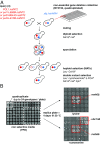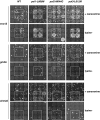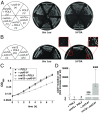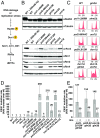Alterations in cellular metabolism triggered by URA7 or GLN3 inactivation cause imbalanced dNTP pools and increased mutagenesis
- PMID: 28416670
- PMCID: PMC5465912
- DOI: 10.1073/pnas.1618714114
Alterations in cellular metabolism triggered by URA7 or GLN3 inactivation cause imbalanced dNTP pools and increased mutagenesis
Abstract
Eukaryotic DNA replication fidelity relies on the concerted action of DNA polymerase nucleotide selectivity, proofreading activity, and DNA mismatch repair (MMR). Nucleotide selectivity and proofreading are affected by the balance and concentration of deoxyribonucleotide (dNTP) pools, which are strictly regulated by ribonucleotide reductase (RNR). Mutations preventing DNA polymerase proofreading activity or MMR function cause mutator phenotypes and consequently increased cancer susceptibility. To identify genes not previously linked to high-fidelity DNA replication, we conducted a genome-wide screen in Saccharomyces cerevisiae using DNA polymerase active-site mutants as a "sensitized mutator background." Among the genes identified in our screen, three metabolism-related genes (GLN3, URA7, and SHM2) have not been previously associated to the suppression of mutations. Loss of either the transcription factor Gln3 or inactivation of the CTP synthetase Ura7 both resulted in the activation of the DNA damage response and imbalanced dNTP pools. Importantly, these dNTP imbalances are strongly mutagenic in genetic backgrounds where DNA polymerase function or MMR activity is partially compromised. Previous reports have shown that dNTP pool imbalances can be caused by mutations altering the allosteric regulation of enzymes involved in dNTP biosynthesis (e.g., RNR or dCMP deaminase). Here, we provide evidence that mutations affecting genes involved in RNR substrate production can cause dNTP imbalances, which cannot be compensated by RNR or other enzymatic activities. Moreover, Gln3 inactivation links nutrient deprivation to increased mutagenesis. Our results suggest that similar genetic interactions could drive mutator phenotypes in cancer cells.
Keywords: CTP biosynthesis; DNA polymerases; DNA replication fidelity; dNTP pool imbalance; mismatch repair.
Conflict of interest statement
The authors declare no conflict of interest.
Figures






Comment in
-
DNA replication and mismatch repair safeguard against metabolic imbalances.Proc Natl Acad Sci U S A. 2017 May 30;114(22):5561-5563. doi: 10.1073/pnas.1705971114. Epub 2017 May 22. Proc Natl Acad Sci U S A. 2017. PMID: 28533419 Free PMC article. No abstract available.
Similar articles
-
A genetic screen pinpoints ribonucleotide reductase residues that sustain dNTP homeostasis and specifies a highly mutagenic type of dNTP imbalance.Nucleic Acids Res. 2019 Jan 10;47(1):237-252. doi: 10.1093/nar/gky1154. Nucleic Acids Res. 2019. PMID: 30462295 Free PMC article.
-
Colon cancer-associated mutator DNA polymerase δ variant causes expansion of dNTP pools increasing its own infidelity.Proc Natl Acad Sci U S A. 2015 May 12;112(19):E2467-76. doi: 10.1073/pnas.1422934112. Epub 2015 Mar 31. Proc Natl Acad Sci U S A. 2015. PMID: 25827231 Free PMC article.
-
dNTP pool levels modulate mutator phenotypes of error-prone DNA polymerase ε variants.Proc Natl Acad Sci U S A. 2015 May 12;112(19):E2457-66. doi: 10.1073/pnas.1422948112. Epub 2015 Mar 31. Proc Natl Acad Sci U S A. 2015. PMID: 25827226 Free PMC article.
-
DNA precursor metabolism and genomic stability.FASEB J. 2006 Jul;20(9):1300-14. doi: 10.1096/fj.06-5730rev. FASEB J. 2006. PMID: 16816105 Review.
-
Eukaryotic Mismatch Repair in Relation to DNA Replication.Annu Rev Genet. 2015;49:291-313. doi: 10.1146/annurev-genet-112414-054722. Annu Rev Genet. 2015. PMID: 26436461 Free PMC article. Review.
Cited by
-
Arginine limitation drives a directed codon-dependent DNA sequence evolution response in colorectal cancer cells.Sci Adv. 2023 Jan 6;9(1):eade9120. doi: 10.1126/sciadv.ade9120. Epub 2023 Jan 6. Sci Adv. 2023. PMID: 36608131 Free PMC article.
-
Rad5 and Its Human Homologs, HLTF and SHPRH, Are Novel Interactors of Mismatch Repair.Front Cell Dev Biol. 2022 Jun 16;10:843121. doi: 10.3389/fcell.2022.843121. eCollection 2022. Front Cell Dev Biol. 2022. PMID: 35784486 Free PMC article.
-
DNA damage response activates respiration and thereby enlarges dNTP pools to promote cell survival in budding yeast.J Biol Chem. 2019 Jun 21;294(25):9771-9786. doi: 10.1074/jbc.RA118.007266. Epub 2019 May 9. J Biol Chem. 2019. PMID: 31073026 Free PMC article.
-
Urea Cycle Dysregulation Generates Clinically Relevant Genomic and Biochemical Signatures.Cell. 2018 Sep 6;174(6):1559-1570.e22. doi: 10.1016/j.cell.2018.07.019. Epub 2018 Aug 9. Cell. 2018. PMID: 30100185 Free PMC article.
-
DNA polymerase δ proofreads errors made by DNA polymerase ε.Proc Natl Acad Sci U S A. 2020 Mar 17;117(11):6035-6041. doi: 10.1073/pnas.1917624117. Epub 2020 Mar 2. Proc Natl Acad Sci U S A. 2020. PMID: 32123096 Free PMC article.
References
-
- Ganai RA, Johansson E. DNA replication—a matter of fidelity. Mol Cell. 2016;62:745–755. - PubMed
Publication types
MeSH terms
Substances
LinkOut - more resources
Full Text Sources
Other Literature Sources
Molecular Biology Databases

